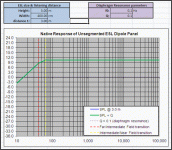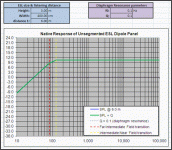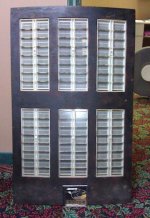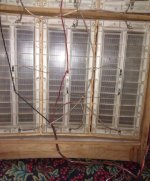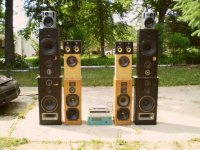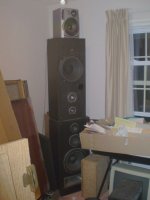With a finite rather than infinite segmented wall, there will be left and right boundaries to the listening area(shown in the figure) you would need to stay inside of for the image to stay centered in front of you. The listening area boundaries narrow as delay is increased and the angle of the virtual sources are spread further apart. Also, moving further away from the wall of ESLs narrows the left and right boundaries of the listening area.
But as you move off to the left, isn't L getting louder and earlier? Isn't the delay (and distances) making things exactly worse? (Isn't that what "toe-in" of speaker boxes tries to over-come?)
Ummm.... just occurred to me: didn't Walker feed from the centre on the Quads (for frequency and beaming if not for spatial image reasons)? That would change the whole analysis.
Ben
Beaming occur's when the frequency emitted is less than one half wavelength of the width of the Panel, Diaphragm or Aperture that the wave front is being emitted from.
It is a spherical wavefront (cylindrical for a line source) up until that point and as the frequency is raised it starts to become a focused beam.
As the frequency gets higher the beam gets more focused and narrower and also some side lobes start to develop as well.
For instance for a 6" wide panel this transition starts at Aprox. 1Khz and as it approaches 2Khz where 6" equals one wavelength the pattern then becomes a figure 8 (doublet) pattern.
I have shown this in some simulation's here,
A Segmented Stator Desktop ESL
The idea of putting them in a AMT fashion is it to increase the displacement for the lowest frequency's while maintaining a small floor area.
Second, having say 1/2" to 1" (or even maybe up to 2") aperture width helps to maintain a even cylindrical wavefront as the frequency is raised.
There is also a transition that occurs due to the depth (in your case 6" to 8" or so) but I forget the details, But it is explained in one of the AMT threads concerning pleat depth.
I would like to explore this more sometime when I finally get enough panels made.
It will be very labor intensive but I think a decent bass system could be realized with such a system and not take up too much floor space.
I think just 8 panel's or so may be enough to get good results.
Right now it is all just theory and I have yet to see a working system as such, But there have been patents and many discussion about this type of approach.
jer 🙂
It is a spherical wavefront (cylindrical for a line source) up until that point and as the frequency is raised it starts to become a focused beam.
As the frequency gets higher the beam gets more focused and narrower and also some side lobes start to develop as well.
For instance for a 6" wide panel this transition starts at Aprox. 1Khz and as it approaches 2Khz where 6" equals one wavelength the pattern then becomes a figure 8 (doublet) pattern.
I have shown this in some simulation's here,
A Segmented Stator Desktop ESL
The idea of putting them in a AMT fashion is it to increase the displacement for the lowest frequency's while maintaining a small floor area.
Second, having say 1/2" to 1" (or even maybe up to 2") aperture width helps to maintain a even cylindrical wavefront as the frequency is raised.
There is also a transition that occurs due to the depth (in your case 6" to 8" or so) but I forget the details, But it is explained in one of the AMT threads concerning pleat depth.
I would like to explore this more sometime when I finally get enough panels made.
It will be very labor intensive but I think a decent bass system could be realized with such a system and not take up too much floor space.
I think just 8 panel's or so may be enough to get good results.
Right now it is all just theory and I have yet to see a working system as such, But there have been patents and many discussion about this type of approach.
jer 🙂
Last edited:
Many thanks for links (and I browse at that nice emerging forum too). Good bed-time reading for me.
Alas (and here my own professional biases begin to show), that's the birds' eyes views. But what if you were to ask, "What helps or hinders my perception (or localization or tingle or enjoyment) of the sound of the English horn slightly right of centre and halfway back?"
The defect of beaming in ESLs (like the defect of longitudinal torque reaction on my BMW motorcycle) is obvious to everyone except owners after a few days experience, let alone 35 and 45 years respectively.
That's not a quibble: the dramatic lobe-filled polar charts really bear little relation to sound at a listener's chair and the perception of a speaker. Imagine that you or I made a drawing of our perceived polar response.
Must be less cumbersome ways to do what an AMT is supposed to do, however worthwhile the goal might be.
Ben
Alas (and here my own professional biases begin to show), that's the birds' eyes views. But what if you were to ask, "What helps or hinders my perception (or localization or tingle or enjoyment) of the sound of the English horn slightly right of centre and halfway back?"
The defect of beaming in ESLs (like the defect of longitudinal torque reaction on my BMW motorcycle) is obvious to everyone except owners after a few days experience, let alone 35 and 45 years respectively.
That's not a quibble: the dramatic lobe-filled polar charts really bear little relation to sound at a listener's chair and the perception of a speaker. Imagine that you or I made a drawing of our perceived polar response.
Must be less cumbersome ways to do what an AMT is supposed to do, however worthwhile the goal might be.
Ben
But as you move off to the left, isn't L getting louder and earlier? Isn't the delay (and distances) making things exactly worse? (Isn't that what "toe-in" of speaker boxes tries to over-come?)
Short version:
getting louder = no
getting earlier = yes
Long version:
Sound intensity will be independent of distance from the diaphragm and always in a direction perpendicular to the wave front. Basically you are in the near field of the ESL at all positions. Having never build a full-wall ESL I haven’t experienced it. But I do know that a floor-to-ceiling line source provides a near uniform sound when my head is moved above and below the middle of the panel, and the image stays right in front of me(perpendicular to the panel) as I move my head up and down. If the panel is tipped forward or backward, the image shifts by the same angle. Yes, moving away from a line source and the sound intensity falls by -3dB for doubling of distance. But this is only because sound is spreading out to the left and right rather than being contained as it is top to bottom in a floor to ceiling beam. If the width of the ESL line source is expanded wall to wall as well, the wave front will not spread out in that direction either and intensity will be independent of listening distance.
NOW, concerning distances to left & right wave fronts when you move away from the center position:
Ooh! Excellent point! Apologies for being slow on the uptake. In a worst case situation with the listener positioned on the right hand edge of the right wave front and at a close 2m listening distance, the left wave front would arrive on the order of 1mS after the right wave front. So, while direction and intensity are properly retained at off center positions(as Walker states), timing between the channels is not(which Walker doesn't discuss).Certainly less than optimal for the top-shelf imaging you probably have in mind, except on axis.
Soooo why did we build this wall sized ESL? Move along, nothing to see here…
I'm not sure that toe-in of box speakers relates to this. With the polar response of box speaker in mind, generally toe-in is used to juggle first arrival frequency response and lateral reflections to provide the best perceived tonal balance and image with a sense of space and specificity.
Yes, ESL-63s have concentric rings fed from the center with delay between the rings configured to produce a 2D curved wave front to emulate a point source positioned about 40cm behind the diaphragm. Similar to the wall-sized ESL, there is a boundary beyond which the point source emulation fails and the panel beaming behavior reverts to something more like that of a panel the size of its central ring.Ummm.... just occurred to me: didn't Walker feed from the centre on the Quads (for frequency and beaming if not for spatial image reasons)? That would change the whole analysis.
Last edited:
Bolserst - thanks for one more highly informative clarification.
But one thing you said seems to defy the Laws of Physics, at least those laws known to earthlings with high school physics: "Sound intensity will be independent of distance from the diaphragm."
Is that right? Not even 3dB loss....?
Ben
But one thing you said seems to defy the Laws of Physics, at least those laws known to earthlings with high school physics: "Sound intensity will be independent of distance from the diaphragm."
Is that right? Not even 3dB loss....?
Ben
But one thing you said seems to defy the Laws of Physics, at least those laws known to earthlings with high school physics: "Sound intensity will be independent of distance from the diaphragm."
I guess there are two ways to look at this:
1) From Walker's perspective the wall ESL at one end of a room could be thought of as a piston connected to the end of a pipe. Sound waves travel down pipes with very little loss. Granted the room is a very short pipe, and as Walker mentions requires a large amount of damping at the end to avoid reflection and standing waves. But, there will be very little loss traveling down the "tube" from one end of the room to the other.
2) Looking at the ESL alone without any walls around it, you would still have a flat response independent of distance as long as you are in the near field.
The formula for determining near/far field transition relative to a panel dimension is:
F = c * r / d^2
where:
c = speed of sound
r = listening distance
d = panel dimension
The calculated frequency is where the wavelength of sound is getting long enough relative to the panel dimension for the sound wave to start spreading out rather than being beamed perpendicular to the panel. So, the further you moved from the panel, the sooner the low frequencies start rolling off at 6dB/oct.
More information along with a calculator here:
http://www.diyaudio.com/forums/plan...r-esl-simulator-esl_seg_ui-2.html#post2913884
As an example, suppose we had a wall-sized ESL (4m x 5m) and hung it out in free space. If we compared response at listening positions of 3m and 6m distant from the ESL, the response above 100Hz would be flat and identical in level. The only difference would be that at 6m the roll off in the bass would start sooner as discussed above.
Attachments
Here are the front and back pictures, as requested by Andersonix. Sorry pictures not better. CD jewel case shown for scale.
Pair of panels built around 1976 (if you are fooling with speakers and save your experiments, very good to have a house with 21 rooms). Originally powered by an oil furnace ignition transformer and two Dynaco Stereo 70 output transformers. Later, by custom HV supply and 2400 v B+ direct-drive Sanders-like amp.
These are XG8 cells, packed as closely as I could (see the back). Dayton-Wright gear is like "MIL-SPEC" construction quality among HiFi manufacturers and some other brands look like they were made in a garage. Of course, I made the crude wiring... only the cells are DW.
Each cell is 6.5 x 15.5 inches at the opening (16 cm x 40 cm). I've never measured these cells with good test equipment but they sound absolutely great to beyond my hearing range. Possibly best home audio I've ever made and possibly, ever heard, exemplifying ESL virtues like transparency and clean treble. For sure, no bass like the intact gas-filled DW XG8 or XG10 speakers (my current mid-ranges).
Ben
Pair of panels built around 1976 (if you are fooling with speakers and save your experiments, very good to have a house with 21 rooms). Originally powered by an oil furnace ignition transformer and two Dynaco Stereo 70 output transformers. Later, by custom HV supply and 2400 v B+ direct-drive Sanders-like amp.
These are XG8 cells, packed as closely as I could (see the back). Dayton-Wright gear is like "MIL-SPEC" construction quality among HiFi manufacturers and some other brands look like they were made in a garage. Of course, I made the crude wiring... only the cells are DW.
Each cell is 6.5 x 15.5 inches at the opening (16 cm x 40 cm). I've never measured these cells with good test equipment but they sound absolutely great to beyond my hearing range. Possibly best home audio I've ever made and possibly, ever heard, exemplifying ESL virtues like transparency and clean treble. For sure, no bass like the intact gas-filled DW XG8 or XG10 speakers (my current mid-ranges).
Ben
Attachments
Last edited:
Here are the drawings i was trying to find earlier,
http://www.diyaudio.com/forums/planars-exotics/190023-horn-loaded-electrostatic-3.html#post2999103
jer 🙂
http://www.diyaudio.com/forums/planars-exotics/190023-horn-loaded-electrostatic-3.html#post2999103
jer 🙂
Gerald and Bolserst -
Pardon my obtuseness, I think I finally have it now. But let me begin by dropping that disinformative marketing name "AMT" and just saying "accordion-folded" or just "folded" or "pleated... like a filter."
Yes, a guy with a lot of cells can make an ESL woofer if they are folded to save room. The construction of a folded ESL is vastly more complicated than mounting plane films flat because of the number of edges to be sealed and their meandering shape.
For my Dayton-Wright cell shape, I think I could put twice the cells per inch of width. Twice more than plane but that's vastly less than the way pleated air-filters for car engines are packaged, or the imaginative patent drawings for AMTs.
Anybody ever heard such a thing? I wonder what the treble would sound like since the folded package has to be contained in a box or frame and the diaphragms are bouncing the treble off one another.....
Now a guy with a lot of cells AND a lot of wall AND a few 39-lb Dayton-Wright 1:100 transformers, might make one swell plane ESL sub-woofer (without needing to pleat them). Hmmmm.
Footnote: the bass from a pair of the gas-filled one-meter-square 8-cell Dayton-Wright ESLs is quite satisfying although far from profound. And more so, I would suppose, in the double-pair that Mike Wright advocated for theatres and that some owners use. BTW, that good bass also makes you wonder about the OB theory that predicts bass ought to be missing.
Ben
Pardon my obtuseness, I think I finally have it now. But let me begin by dropping that disinformative marketing name "AMT" and just saying "accordion-folded" or just "folded" or "pleated... like a filter."
Yes, a guy with a lot of cells can make an ESL woofer if they are folded to save room. The construction of a folded ESL is vastly more complicated than mounting plane films flat because of the number of edges to be sealed and their meandering shape.
For my Dayton-Wright cell shape, I think I could put twice the cells per inch of width. Twice more than plane but that's vastly less than the way pleated air-filters for car engines are packaged, or the imaginative patent drawings for AMTs.
Anybody ever heard such a thing? I wonder what the treble would sound like since the folded package has to be contained in a box or frame and the diaphragms are bouncing the treble off one another.....
Now a guy with a lot of cells AND a lot of wall AND a few 39-lb Dayton-Wright 1:100 transformers, might make one swell plane ESL sub-woofer (without needing to pleat them). Hmmmm.
Footnote: the bass from a pair of the gas-filled one-meter-square 8-cell Dayton-Wright ESLs is quite satisfying although far from profound. And more so, I would suppose, in the double-pair that Mike Wright advocated for theatres and that some owners use. BTW, that good bass also makes you wonder about the OB theory that predicts bass ought to be missing.
Ben
Last edited:
Yes, very good points!
I am sure that the highs would be lacking much so for such a system as a function of the depth of the sections (pleats).
As for as the bass is concerned I am glad to hear that it my be a feasible idea although quite very labor and material intensive.
I figure that a 4sqft. panel has about the some displacement of one 12"woofer at an acceptable SPL's.
It would take 8 panels to make up the 6db drop do to the dipole action and of course the more panels the better.
I am thinking of such a system that is small for my Desktop design, I just need to work out the construction details.
Spreading the panels out over a large area would definitely work as I am trying to think of ways to decrease the foot print (floor space).
Another thing I was thinking about was to use about 16 panels to corner load the room with.
With the panels parallel to the walls and sealed at the apex (corner).
I was thinking of a system of about 32sqft. per corner with 4 1' X 4' on each wall (8 total per corner) 8' tall.
I don't have my camera right now or else I would draw a sketch and post it for you.
I am not sure exactly if this would work but I got the crazy idea from the David Lucas Shockwave ESL sub plans so I have yet to work out the details.
I am using 2 X 10's facing into each corner right now behind my main stack of cabinets with a 250Hz passive crossover and this works very good for me.
Although they are monopole and are in phase and parallel with the corresponding stack (see picture).
I will know more too if this is going to work once I start building some larger panels.
This about to change anyhow because 3 of the 12's are now burn't.
I am leaning toward a tall dipole stack of 8's or per side at the moment.
If The ESL's in the corner idea does work then it will have a very large surface area in tucked in a small area of floor space.
Once, I get the panels made I don't want those big bulky boxes as there won't be any room for them once they are setup!!
Just a few thoughts FWIW.
jer 🙂
I am sure that the highs would be lacking much so for such a system as a function of the depth of the sections (pleats).
As for as the bass is concerned I am glad to hear that it my be a feasible idea although quite very labor and material intensive.
I figure that a 4sqft. panel has about the some displacement of one 12"woofer at an acceptable SPL's.
It would take 8 panels to make up the 6db drop do to the dipole action and of course the more panels the better.
I am thinking of such a system that is small for my Desktop design, I just need to work out the construction details.
Spreading the panels out over a large area would definitely work as I am trying to think of ways to decrease the foot print (floor space).
Another thing I was thinking about was to use about 16 panels to corner load the room with.
With the panels parallel to the walls and sealed at the apex (corner).
I was thinking of a system of about 32sqft. per corner with 4 1' X 4' on each wall (8 total per corner) 8' tall.
I don't have my camera right now or else I would draw a sketch and post it for you.
I am not sure exactly if this would work but I got the crazy idea from the David Lucas Shockwave ESL sub plans so I have yet to work out the details.
I am using 2 X 10's facing into each corner right now behind my main stack of cabinets with a 250Hz passive crossover and this works very good for me.
Although they are monopole and are in phase and parallel with the corresponding stack (see picture).
I will know more too if this is going to work once I start building some larger panels.
This about to change anyhow because 3 of the 12's are now burn't.
I am leaning toward a tall dipole stack of 8's or per side at the moment.
If The ESL's in the corner idea does work then it will have a very large surface area in tucked in a small area of floor space.
Once, I get the panels made I don't want those big bulky boxes as there won't be any room for them once they are setup!!
Just a few thoughts FWIW.
jer 🙂
Attachments
ESLs, bass, and corners... some ideas that have never mixed before. I wonder how you would put an ESL into a corner and how to deal with or benefit from the rear wave?
About the dipole bass cut, I think practical experience is quite different than the theoretical expectation. Not just the boost from the resonance of a free air driver. I think once a baffle is irregular in shape, mounted in a reflective (always irregular) room, and tested by ear, all bets are off. There is also no question in my mind that the OB people are really on the right track saying the sound is better when there is no box (and more so for getting rid of BR boxes forever).
And I'm a guy who supplements the south end of Klipschorn's response with an OB.
Footnote for Gerald: the Dayton-Wright bias supply adjusts up to something like 15,000 volts.
Ben
About the dipole bass cut, I think practical experience is quite different than the theoretical expectation. Not just the boost from the resonance of a free air driver. I think once a baffle is irregular in shape, mounted in a reflective (always irregular) room, and tested by ear, all bets are off. There is also no question in my mind that the OB people are really on the right track saying the sound is better when there is no box (and more so for getting rid of BR boxes forever).
And I'm a guy who supplements the south end of Klipschorn's response with an OB.
Footnote for Gerald: the Dayton-Wright bias supply adjusts up to something like 15,000 volts.
Ben
Last edited:
Yes, This is so very true as these are just theory's and idea's that have yet to be tried.
I discovered the OB design back when I was a kid in the mid 70's and I had found that the small drivers that I tore out of old radio's ranging from 2" to 8" all sounded so much better when I took them out of there enclosure and instead held them next to my ear.
I listened to these for a very long hours like this with a very tired arm, But the sound was so much better.
It wasn't until recently that I now completely understand the concept.
One of the main reasons is that when drivers are operated in free air and not loaded in a box of some sort, They are able to move more freely and the result is a much lower THD factor than one that is put into a box.
I have tested this with some drivers of my 8" sub drivers and the results were very impressive and I was very surprised at what I had found.
The Second ( as you already know) is the reduction of the level of excited room modes and this equates to a reduction of early reflections, Although this was not an issue when I was holding the driver next to my ear.
Yes, I am aware of the very high bias voltages of the Dayton/Wright drivers.
I am very fascinated by this and have been on many search's for inert gasses and how to get my hands on them, I just never got as far yet as to get any.
The one thing I meant to mention is that when I put the woofers in the corners out of phase (Dipole if you will) I get a much cleaner low end but at a much reduced volume as well.
So, I kept them in phase (bipolar), it is too bad that the system is not functional anymore. 🙁
I had stuffed the cabinets full of insulation and kept the ports open only so that they can breathe and the result was a very clean (due to the many drivers) and highly dampened and very tight transient bass, The kind you could feel in the chest with out being at all muddy what so ever.
Listening to the bass in Johnny Joe Whites "Polka Salad Anne" was euphoria!!!
The system was flat down to about 25-30Hz and the THD was the highest in this range but only about 5% as it dropped off sharply by 50Hz or so.
I have the measurement curves still but they are not on this machine, But I can dig them up if you wish to see them.
I do have them posted in one of the threads as well.
I am hoping that my idea of such a large area of ESL's in the corners will produce this kind of bass as well.
Being that they will be close to the wall I am expecting a compression type of action to excite the room with and will be strictly for bass frequency's.
Cheers !!!
jer 🙂
I discovered the OB design back when I was a kid in the mid 70's and I had found that the small drivers that I tore out of old radio's ranging from 2" to 8" all sounded so much better when I took them out of there enclosure and instead held them next to my ear.
I listened to these for a very long hours like this with a very tired arm, But the sound was so much better.
It wasn't until recently that I now completely understand the concept.
One of the main reasons is that when drivers are operated in free air and not loaded in a box of some sort, They are able to move more freely and the result is a much lower THD factor than one that is put into a box.
I have tested this with some drivers of my 8" sub drivers and the results were very impressive and I was very surprised at what I had found.
The Second ( as you already know) is the reduction of the level of excited room modes and this equates to a reduction of early reflections, Although this was not an issue when I was holding the driver next to my ear.
Yes, I am aware of the very high bias voltages of the Dayton/Wright drivers.
I am very fascinated by this and have been on many search's for inert gasses and how to get my hands on them, I just never got as far yet as to get any.
The one thing I meant to mention is that when I put the woofers in the corners out of phase (Dipole if you will) I get a much cleaner low end but at a much reduced volume as well.
So, I kept them in phase (bipolar), it is too bad that the system is not functional anymore. 🙁
I had stuffed the cabinets full of insulation and kept the ports open only so that they can breathe and the result was a very clean (due to the many drivers) and highly dampened and very tight transient bass, The kind you could feel in the chest with out being at all muddy what so ever.
Listening to the bass in Johnny Joe Whites "Polka Salad Anne" was euphoria!!!
The system was flat down to about 25-30Hz and the THD was the highest in this range but only about 5% as it dropped off sharply by 50Hz or so.
I have the measurement curves still but they are not on this machine, But I can dig them up if you wish to see them.
I do have them posted in one of the threads as well.
I am hoping that my idea of such a large area of ESL's in the corners will produce this kind of bass as well.
Being that they will be close to the wall I am expecting a compression type of action to excite the room with and will be strictly for bass frequency's.
Cheers !!!
jer 🙂
Gerald, I have almost 100 dayton wright cells in their original frames, 4 step up transformers and other parts if your interested in anything,. Ben got his parts last week.
That sounds Great ticknpop!!
I will consider getting some from you sometime.
Right now I don't have the funds at the moment, until I can get some work and cash flow around here.
I have been on sort of a vacation for a while and I am now ready to get back out there into the working force again. 🙂
jer 🙂
I will consider getting some from you sometime.
Right now I don't have the funds at the moment, until I can get some work and cash flow around here.
I have been on sort of a vacation for a while and I am now ready to get back out there into the working force again. 🙂
jer 🙂
Gerald, I have almost 100 dayton wright cells in their original frames, 4 step up transformers and other parts if your interested in anything,. Ben got his parts last week.
I can't say nice enough things about dealing with ticknpop. Very good fellow. Need I say more.
Ben
1.) With the whole front wall room covered with such array of dynamic drivers or ESL, then what is frequency do we need define ka=1?Short version:
getting louder = no
getting earlier = yes
Long version:
Sound intensity will be independent of distance from the diaphragm and always in a direction perpendicular to the wave front. Basically you are in the near field of the ESL at all positions. Having never build a full-wall ESL I haven’t experienced it. But I do know that a floor-to-ceiling line source provides a near uniform sound when my head is moved above and below the middle of the panel, and the image stays right in front of me(perpendicular to the panel) as I move my head up and down. If the panel is tipped forward or backward, the image shifts by the same angle. Yes, moving away from a line source and the sound intensity falls by -3dB for doubling of distance. But this is only because sound is spreading out to the left and right rather than being contained as it is top to bottom in a floor to ceiling beam. If the width of the ESL line source is expanded wall to wall as well, the wave front will not spread out in that direction either and intensity will be independent of listening distance.
NOW, concerning distances to left & right wave fronts when you move away from the center position:
Ooh! Excellent point! Apologies for being slow on the uptake. In a worst case situation with the listener positioned on the right hand edge of the right wave front and at a close 2m listening distance, the left wave front would arrive on the order of 1mS after the right wave front. So, while direction and intensity are properly retained at off center positions(as Walker states), timing between the channels is not(which Walker doesn't discuss).Certainly less than optimal for the top-shelf imaging you probably have in mind, except on axis.
Soooo why did we build this wall sized ESL? Move along, nothing to see here…
2.) if we do know the frequency where the ka=1 is, then at ka<1, do we still have the air mass load mass reactance and also compliance controlled region?
With the whole front wall covered, the concept of ka=1 is not relevant. Instead of the radiation impedance defining the acoustic load on the front side of the ESL or array of dynamic drivers, the acoustic load will be dominated by the pressure and velocity distributions from the room modes. Of course whatever is on the backside of the wall of drivers or ESLs will also be acoustically loading the drivers.
- Home
- Loudspeakers
- Planars & Exotics
- If you had a lot of ESL panels....
